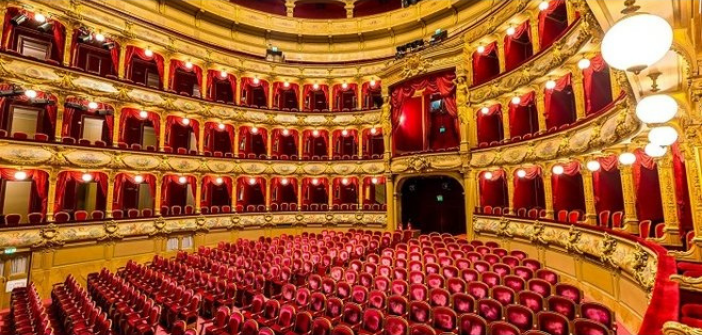At the workshops of the Diacosmie of the Opéra de Nice, the first work of the season was by François Adrien Boieldieu, “La Dame Blanche,” resurrected from the 19th century, which inspired Rossini, Wagner, and Bizet.
Originally scheduled at the Opera and streamed due to Covid reasons a year ago, this performance takes place on a stage without an orchestra pit. Conductor Alexandra Cravero leads, with her back to the singers and choirs situated on either side of the stage, but her actions are filmed on camera. The fate of the Count Avenel’s castle in Scotland is played out. It is a story full of twists and turns, drawn from two novels by Walter Scott, “The Monastery” and “Guy Mannering,” with a libretto by Eugène Scribe. This minimalist setup features no scenery but offers an interesting proximity with the audience and between the performers themselves: choirs, singers, and orchestra.
The scenes are interspersed with text like in theater, and not recitatives like in Mozart’s works. The audience’s attention is more captivated. In fact, it is a theater director, Pauline Bureau, who collaborated on the staging designed by Valérie Nègre. The characters, whose psychology is explored over the three acts, are whimsical and surprising.
This is exemplified by the mezzo-soprano Sophie Marin Degor, who plays Jenny, tending to her little one with great naturalness alongside her timid husband, the farmer who fears encountering the White Lady, the ghost of the young girl raised by the Count and Countess, a statue to be found in the Castle, or the true lover of the soldier George Brown whom she remembers nursing once, and who is none other than the famous Julien, the mysteriously disappeared son who seeks the inheritance.
Embodied by the Rossini tenor Patrick Kabongo with engaging enthusiasm, this positive hero, if there ever was one, combines the Romantic and fantastic art of this Opera with the delicacy of French music from that era. One can also detect bel canto, especially in very high-pitched passages imposed by the score.
The role of the antagonist Gavestone is often played by a baritone. Here, Laurent Kubla, quite charismatic as the former servant of the Count, wishes to claim the estate for himself.
Finally, the title role of Anna is held by the great coloratura soprano Amélie Robins, whose fresh voice plunges us between dreamlike and reality. Fantasy, laughter, and nods sometimes to other works remind us of the comedic nature of this Opera, which was very popular at its premiere in 1825 but has since been forgotten. The conductor sometimes accompanies the beginning of certain arias by humming.
It is fortunate that it has been revisited in these spaces filled with other ghosts, the costumes and staging props from previous seasons’ works that can be admired on the way to the Jedrinsky room, on the initiative of the Opera’s Director, Bertrand Rossi.
Innovative is this second stage in the Diacosmie workshops and this semi-staged format for this co-production by Opéra Comique, Opéra Nice Côte d’Azur, and Opéra de Limoges, but it is a consequence of the provisional use of the Opera for theatrical performances following the sad and highly questionable upcoming demolition of the national dramatic center TNN.
Roland Haugade


